Antibacterial Activity of Electrodeposited Copper and Zinc on Metal Injection Molded (MIM) Micropatterned WC-CO Hard Metals
Abstract
:1. Introduction
2. Materials and Methods
2.1. Sample Preparation
2.2. Electrodeposition of Copper and Zinc
2.3. Tribological Wear
2.4. Surface Morphology Characterization
2.5. Antibacterial Activity of Copper and Zinc Coatings
3. Results and Discussion
3.1. Characterization of Electrodeposited Metal Coatings
3.2. Protective Micropillars with Electrodeposited Copper Coatings
3.3. Protective Micropillars with Electrodeposited Zinc Coatings
3.4. Antibacterial Activity of Copper and Zinc Coatings
4. Conclusions
Author Contributions
Funding
Institutional Review Board Statement
Informed Consent Statement
Data Availability Statement
Conflicts of Interest
References
- Aminov, R.I. A brief history of the antibiotic era: Lessons learned and challenges for the future. Front. Microbiol. 2010, 1, 134. [Google Scholar] [CrossRef] [Green Version]
- Turner, R.J. Metal-based antimicrobial strategies. Microb. Biotechnol. 2017, 10, 1062–1065. [Google Scholar] [CrossRef] [PubMed]
- Borkow, G.; Zhou, S.S.; Page, T.; Gabbay, J. A novel anti-influenza copper oxide containing respiratory face mask. PLoS ONE 2010, 5, e11295. [Google Scholar] [CrossRef] [PubMed] [Green Version]
- Borkow, G.; Lara, H.H.; Covington, C.Y.; Nyamathi, A.; Gabbay, J. Deactivation of human immunodeficiency virus type 1 in medium by copper oxide-containing filters. Antimicrob. Agents Chemother. 2008, 52, 518–525. [Google Scholar] [CrossRef] [PubMed] [Green Version]
- Gabbay, J.; Borkow, G.; Mishal, J.; Magen, E.; Zatcoff, R.; Shemer-Avni, Y. Copper oxide impregnated textiles with potent biocidal activities. J. Ind. Text. 2006, 35, 323–335. [Google Scholar] [CrossRef]
- Borkow, G.; Gabbay, J. Putting copper into action: Copper-impregnated products with potent biocidal activities. FASEB J. 2004, 18, 1728–1730. [Google Scholar] [CrossRef]
- Faúndez, G.; Troncoso, M.; Navarrete, P.; Figueroa, G. Antimicrobial activity of copper surfaces against suspensions of Salmonella enterica and Campylobacter jejuni. BMC Microbiol. 2004, 4, 1–7. [Google Scholar] [CrossRef] [PubMed] [Green Version]
- Monteiro, S.C.; Lofts, S.; Boxall, A.B.A. Pre-assessment of environmental impact of zinc and copper used in animal nutrition. EFSA Support. Publ. 2017, 7, 74E. [Google Scholar] [CrossRef] [Green Version]
- Amachawadi, R.G.; Shelton, N.W.; Shi, X.; Vinasco, J.; Dritz, S.S.; Tokach, M.D.; Nelssen, J.L.; Scott, H.M.; Nagaraja, T.G. Selection of fecal enterococci exhibiting tcrB-mediated copper resistance in pigs fed diets supplemented with copper. Appl. Environ. Microbiol. 2011, 77, 5597–5603. [Google Scholar] [CrossRef] [PubMed] [Green Version]
- Jacob, M.E.; Fox, J.T.; Nagaraja, T.G.; Drouillard, J.S.; Amachawadi, R.G.; Narayanan, S.K. Effects of feeding elevated concentrations of copper and zinc on the antimicrobial susceptibilities of fecal bacteria in feedlot cattle. Foodborne Pathog. Dis. 2010, 7, 643–648. [Google Scholar] [CrossRef] [PubMed]
- Drelich, A.J.; Miller, J.; Donofrio, R.; Drelich, J.W. Novel durable antimicrobial ceramic with embedded copper sub-microparticles for a steady-state release of copper ions. Materials 2017, 10, 775. [Google Scholar] [CrossRef] [Green Version]
- Wheeldon, L.J.; Worthington, T.; Lambert, P.A.; Hilton, A.C.; Lowden, C.J.; Elliott, T.S.J. Antimicrobial efficacy of copper surfaces against spores and vegetative cells of Clostridium difficile: The germination theory. J. Antimicrob. Chemother. 2008, 62, 522–525. [Google Scholar] [CrossRef] [PubMed] [Green Version]
- Fang, M.; Chen, J.H.; Xu, X.L.; Yang, P.H.; Hildebrand, H.F. Antibacterial activities of inorganic agents on six bacteria associated with oral infections by two susceptibility tests. Int. J. Antimicrob. Agents 2006, 27, 513–517. [Google Scholar] [CrossRef]
- Valko, M.; Morris, H.; Cronin, M. Metals, Toxicity and Oxidative Stress. Curr. Med. Chem. 2005, 12, 1161–1208. [Google Scholar] [CrossRef] [PubMed] [Green Version]
- Jiang, W.; Mashayekhi, H.; Xing, B. Bacterial toxicity comparison between nano- and micro-scaled oxide particles. Environ. Pollut. 2009, 157, 1619–1625. [Google Scholar] [CrossRef]
- Santo, C.E.; Taudte, N.; Nies, D.H.; Grass, G. Contribution of copper ion resistance to survival of Escherichia coli on metallic copper surfaces. Appl. Environ. Microbiol. 2008, 74, 977–986. [Google Scholar] [CrossRef] [Green Version]
- Mandal, P.; Shishodia, A.; Ali, N.; Ghosh, S.; Arora, H.S.; Grewal, H.S.; Ghosh, S.K. Effect of topography and chemical treatment on the hydrophobicity and antibacterial activities of micropatterned aluminium surfaces. Surf. Topogr. Metrol. Prop. 2020, 8, 025017. [Google Scholar] [CrossRef]
- Özcana, S.; Açıkbaş, G.; Açıkbaş, N.Ç. Induced superhydrophobic and antimicrobial character of zinc metal modified ceramic wall tile surfaces. Appl. Surf. Sci. 2018, 438, 136–146. [Google Scholar] [CrossRef]
- Dolid, A.; Gomes, L.C.; Mergulhão, F.J.; Reches, M. Combining chemistry and topography to fight biofilm formation: Fabrication of micropatterned surfaces with a peptide-based coating. Coll. Interfaces B Biointerfaces 2020, 196, 111365. [Google Scholar] [CrossRef]
- Yoo, C.H.; Jo, Y.; Shin, J.H.; Jung, S.; Na, J.-G.; Kang, T.; Lee, J.S. Hierarchical membrane integration of shear stress-resistant nanoparticles and biomimetic micropatterns for ultrahigh and durable biofouling resistance. Chem. Eng. J. 2022, 432, 134363. [Google Scholar] [CrossRef]
- Wang, D.; Sun, Q.; Hokkanen, M.J.; Zhang, C.; Lin, F.-Y.; Liu, Q.; Zhu, S.-P.; Zhou, T.; Chang, Q.; He, B.; et al. Design of robust superhydrophobic surfaces. Nature 2020, 582, 55–59. [Google Scholar] [CrossRef]
- Dawari, C.K.; Haq, I.; Mönkkönen, K.; Suvanto, M.; Saarinen, J.J. Reduced sliding friction on flat and microstructured metal injection molded (MIM) WC-Co hard metals with MoS2 composite lubricants. Tribol. Int. 2021, 160, 107020. [Google Scholar] [CrossRef]
- Dawari, C.K.; Mönkkönen, K.; Suvanto, M.; Saarinen, J.J. Solid lubrication on hard metal specimens with micropits under normal and elevated temperatures. Tribol. Lett. 2022, 70, 30. [Google Scholar] [CrossRef]
- Gunell, M.; Haapanen, J.; Brobbey, K.J.; Saarinen, J.J.; Toivakka, M.; Mäkelä, J.M.; Huovinen, P.; Eerola, E. Antimicrobial characterization of silver nanoparticle-coated surfaces by touch test method. Nanotechnol. Sci. Applic. 2017, 10, 137–145. [Google Scholar] [CrossRef] [PubMed] [Green Version]
- Pasquet, J.; Chevalier, Y.; Couval, E.; Bouvier, D.; Noizet, G.; Morlière, C.; Bolzinger, M.-A. Antimicrobial activity of zinc oxide particles on five micro-organisms of the Challenge Tests related to their physicochemical properties. Int. J. Pharm. 2014, 460, 92–100. [Google Scholar] [CrossRef] [PubMed]
- Tayel, A.A.; El-Tras, W.F.; Moussa, S.; El-Baz, A.F.; Mahrous, H.; Salem, M.F.; Brimer, L. Antibacterial action of zinc oxide nanoparticles against foodborne pathogens. J. Food Saf. 2011, 31, 211–218. [Google Scholar] [CrossRef]
- Applerot, G.; Lipovsky, A.; Dror, R.; Perkas, N.; Nitzan, Y.; Lubart, R.; Gedanken, A. Enhanced antibacterial actiwity of nanocrystalline ZnO due to increased ROS-mediated cell injury. Adv. Funct. Mater. 2009, 19, 842–852. [Google Scholar] [CrossRef]
- Yamamoto, O. Influence of particle size on the antibacterial activity of zinc oxide. Int. J. Inorg. Mater. 2001, 3, 643–646. [Google Scholar] [CrossRef]
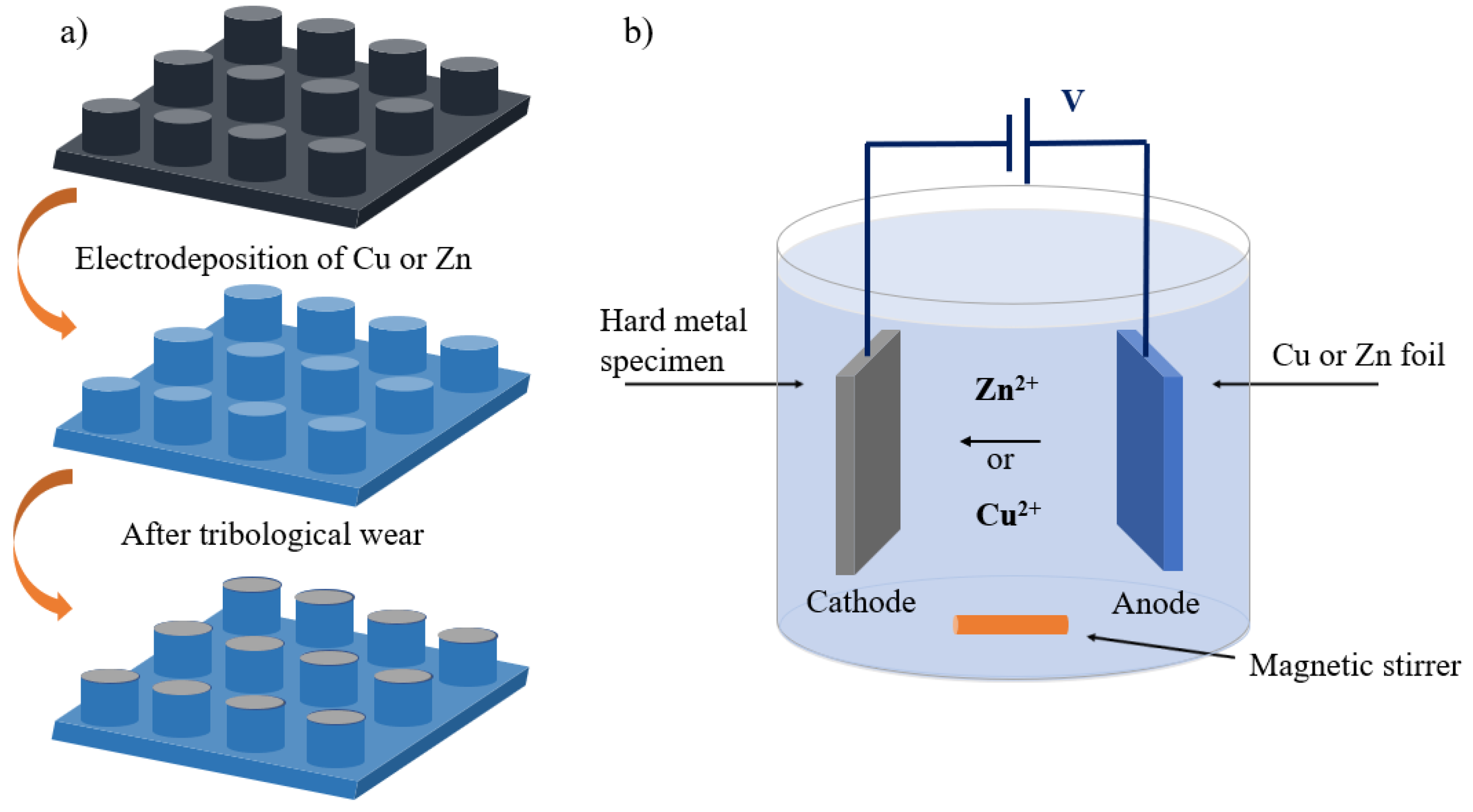
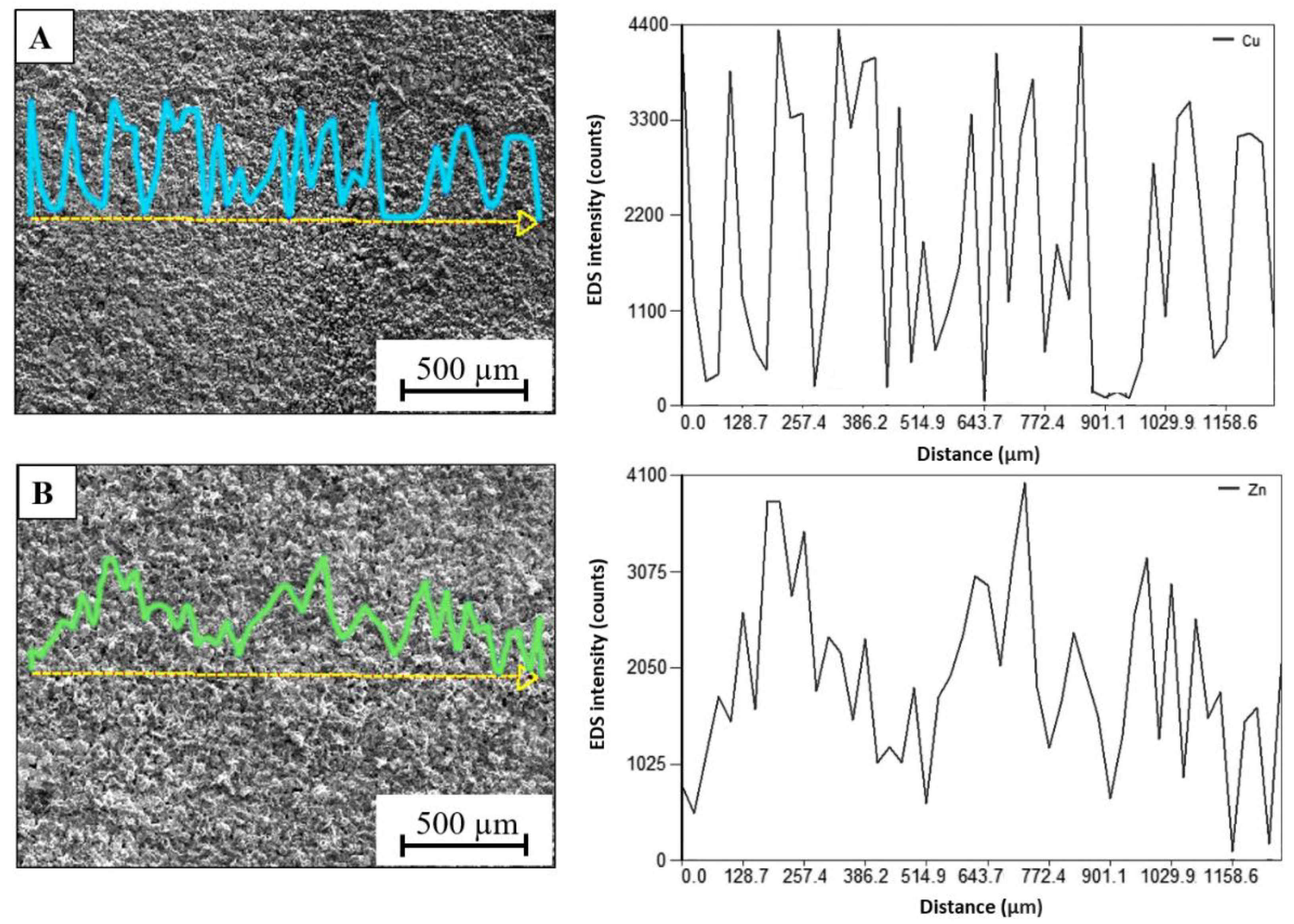
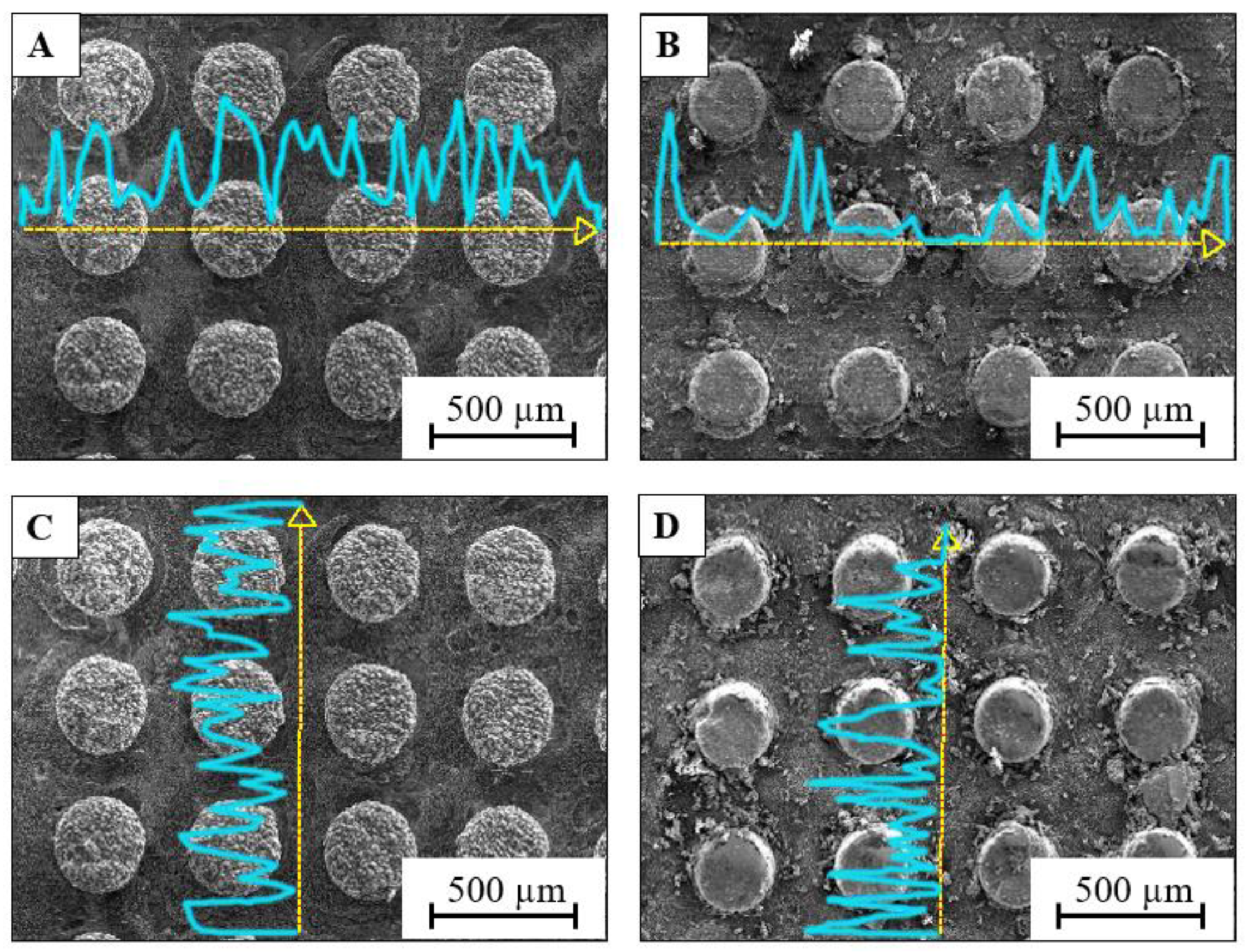
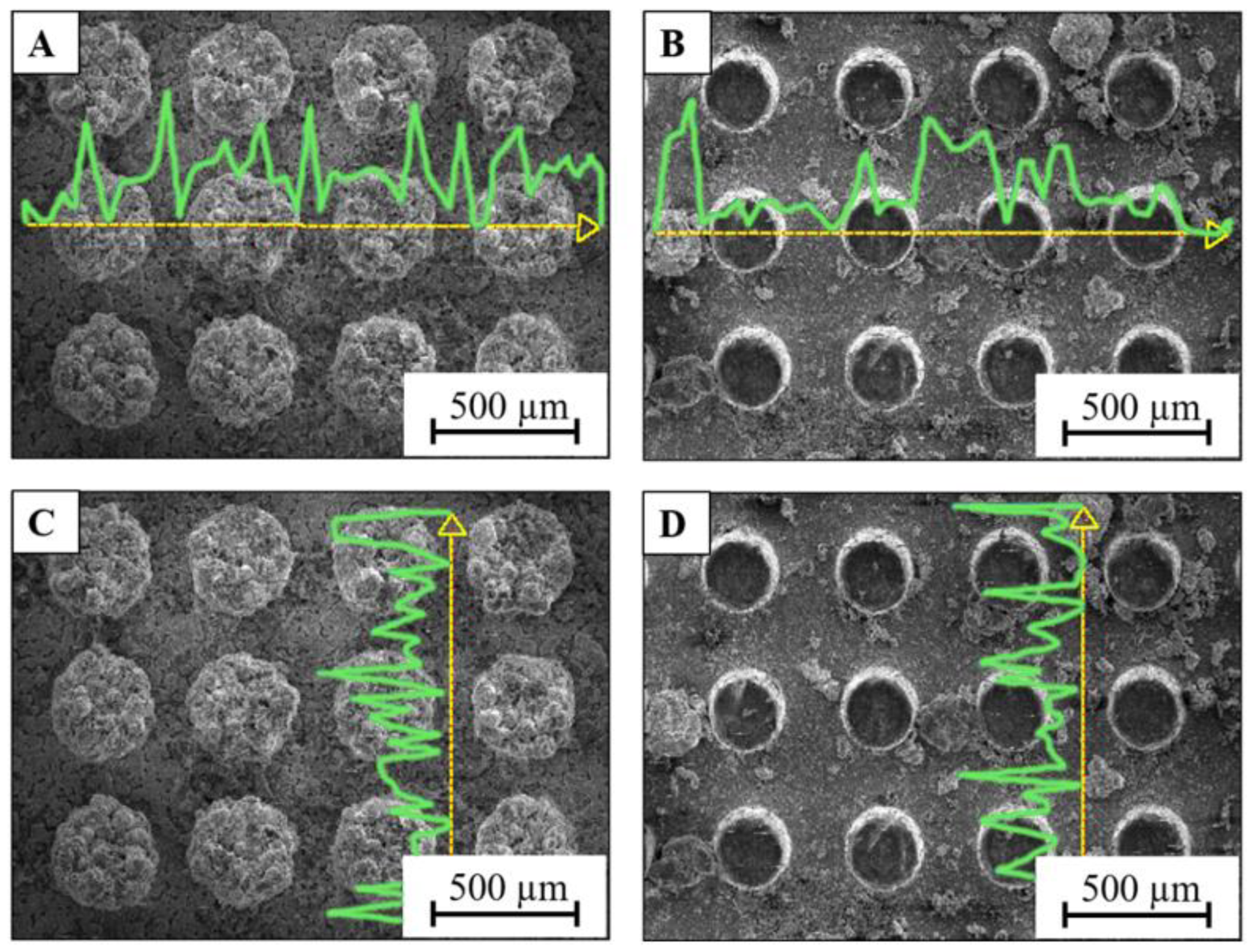
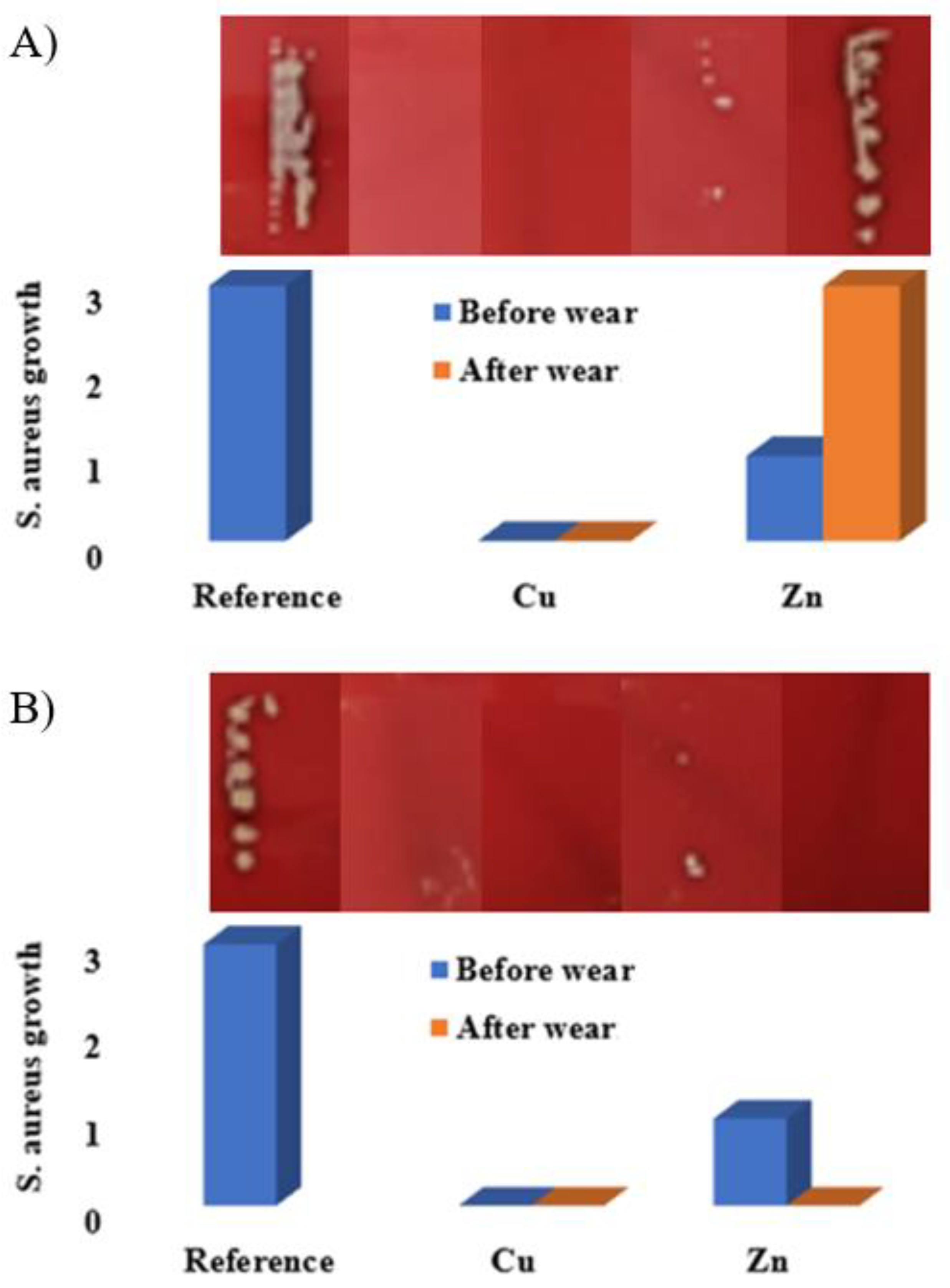
Publisher’s Note: MDPI stays neutral with regard to jurisdictional claims in published maps and institutional affiliations. |
© 2022 by the authors. Licensee MDPI, Basel, Switzerland. This article is an open access article distributed under the terms and conditions of the Creative Commons Attribution (CC BY) license (https://creativecommons.org/licenses/by/4.0/).
Share and Cite
Dawari, C.K.; Gunell, M.; Mönkkönen, K.; Suvanto, M.; Saarinen, J.J. Antibacterial Activity of Electrodeposited Copper and Zinc on Metal Injection Molded (MIM) Micropatterned WC-CO Hard Metals. Coatings 2022, 12, 485. https://doi.org/10.3390/coatings12040485
Dawari CK, Gunell M, Mönkkönen K, Suvanto M, Saarinen JJ. Antibacterial Activity of Electrodeposited Copper and Zinc on Metal Injection Molded (MIM) Micropatterned WC-CO Hard Metals. Coatings. 2022; 12(4):485. https://doi.org/10.3390/coatings12040485
Chicago/Turabian StyleDawari, Christopher K., Marianne Gunell, Kari Mönkkönen, Mika Suvanto, and Jarkko J. Saarinen. 2022. "Antibacterial Activity of Electrodeposited Copper and Zinc on Metal Injection Molded (MIM) Micropatterned WC-CO Hard Metals" Coatings 12, no. 4: 485. https://doi.org/10.3390/coatings12040485
APA StyleDawari, C. K., Gunell, M., Mönkkönen, K., Suvanto, M., & Saarinen, J. J. (2022). Antibacterial Activity of Electrodeposited Copper and Zinc on Metal Injection Molded (MIM) Micropatterned WC-CO Hard Metals. Coatings, 12(4), 485. https://doi.org/10.3390/coatings12040485





